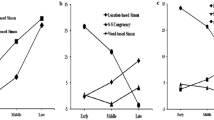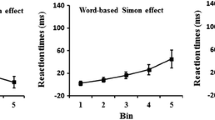Abstract
Responses are more efficient when their spatial mappings with features of targets are compatible compared to when they are incompatible, even when those features are irrelevant to task performance. Currently, a debate exists as to whether spatial information conveyed by different stimulus modes leads to qualitatively different spatial representations. We investigated the relations between three of the most commonly used spatial stimulus modes—arrows, locations, and location words—using correlations of compatibility effects between each of these modes as well as compatibility effects at different segments of their response time distributions. Our results show that when spatial information is irrelevant to task performance (the Simon task), the compatibility effects elicited by arrows and words are more strongly related with each other than with those of locations. However, when spatial information is task relevant (the stimulus–response compatibility SRC task), the compatibility effects elicited by arrows and locations are more related, and both are less related to the effect elicited by words. We suggest that these changing relations between stimulus modes are strategically determined based on which spatial coding technique for arrows is most advantageous to task performance. Furthermore, the varying relations between these spatial compatibility effects indicate that the compatibility effect with one stimulus mode is not always predictive of the compatibility effect in another mode.


Similar content being viewed by others
Notes
Because the focus of the correlational analyses was the overall pattern of relationships between stimulus modes and RT bins, and Bartlett’s test found that the relationships between variables in the correlation matrix were not random, no adjustment was made for multiple comparisons.
References
Borgmann, K. W. U., Risko, E. F., Stolz, J. A., & Besner, D. (2007). Simon says: Reliability and the role of working memory and attentional control in the Simon Task. Psychonomic Bulletin & Review, 14, 313–319.
Cho, D., & Proctor, R. W. (2010). The object-based Simon effect: Grasping affordance or relative location of the graspable part? Journal of Experimental Psychology: Human Perception and Performance, 36, 853–861.
Craft, J. L., & Simon, J. R. (1970). Processing symbolic information from a visual display: Interference from an irrelevant directional cue. Journal of Experimental Psychology, 83, 415–420.
De Jong, R. (1995). Strategical determinants of compatibility effects with task uncertainty. Acta Psychologica, 88, 187–207.
De Jong, R., Liang, C., & Lauber, E. (1994). Conditional and unconditional automaticity: A dual-process model of effects of spatial stimulus-response correspondence. Journal of Experimental Psychology: Human Perception and Performance, 20, 731–750.
Fitts, P. M., & Deininger, R. L. (1954). S–R compatibility: Correspondence among paired elements within stimulus and response codes. Journal of Experimental Psychology, 48, 483–492.
Gratton, G., Coles, M. G., & Donchin, E. (1992). Optimizing the use of information: Strategic control of activation of responses. Journal of Experimental Psychology: General, 121, 480–506.
Hommel, B., Proctor, R. W., & Vu, K.-P. L. (2004). A feature-integration account of sequential effects in the Simon task. Psychological Research, 68, 1–17.
Kornblum, S., Hasbroucq, T., & Osman, A. (1990). Dimensional overlap: Cognitive basis for stimulus–response compatibility—A model and taxonomy. Psychological Review, 97, 253–270.
Lu, C.-H., & Proctor, R. W. (1995). The influence of irrelevant location information on performance: A review of the Simon and spatial Stroop effects. Psychonomic Bulletin & Review, 2, 174–207.
Lu, C.-H., & Proctor, R. W. (2001). Influence of irrelevant information on human performance: Effects of S–R associations strength and relative timing. Quarterly Journal of Experimental Psychology, 54A, 95–136.
Maloney, E. A., Risko, E. F., Preston, F., Ansari, D., & Fugelsang, J. (2010). Challenging the reliability and validity of cognitive measures: The case of the numerical distance effect. Acta Pyschologica, 134, 154–161.
Masaki, H., Takasawa, N., & Yamazaki, K. (2000). An electrophysiological study of the locus of the interference effect in a stimulus-response compatibility paradigm. Psychophysiology, 37, 464–472.
Mayr, U., Awh, E., & Laurey, P. (2003). Conflict adaptation effects in the absence of executive control. Nature Neuroscience, 6, 450–452.
Miles, J. D., & Proctor, R. W. (2009). Reducing and restoring stimulus–response compatibility effects by decreasing the discriminability of location words. Acta Psychologica, 130, 95–102.
Milner, A. D., & Goodale, M. A. (1995). The visual brain in action. Oxford: Oxford University Press.
Mishkin, M., Ungerleider, L. G., & Macko, K. A. (1983). Object vision and spatial vision: Two cortical pathways. Trends in Neuroscience, 6, 414–417.
Nicoletti, R., & Umiltà, C. (1994). Attention shifts produce spatial stimulus codes. Psychological Research, 56, 144–150.
Notebaert, W., De Moor, W., Gevers, W., & Hartsuiker, R. J. (2007). New visuo-spatial associations by training verbo-spatial mappings in the first language. Psychonomic Bulletin & Review, 14, 1183–1188.
Pellicano, A., Lugli, L., Baroni, G., & Nicoletti, R. (2009). The Simon effect with conventional signals: A time-course analysis. Experimental Psychology, 56, 219–227.
Proctor, R. W., & Lu, C.-H. (1999). Processing irrelevant location information: Practice and transfer effects in choice-reaction tasks. Memory & Cognition, 27, 63–77.
Proctor, R. W., Marble, J. G., & Vu, K.-P. L. (2000). Mixing incompatibly mapped location-relevant trials with location-irrelevant trials: Effects of stimulus mode on the reverse Simon effect. Psychological Research, 64, 11–24.
Proctor, R. W., Miles, J. D., & Baroni, G. (2011). Reaction-time distribution analysis of spatial correspondence effects. Psychonomic Bulletin & Review, 18, 242–266.
Proctor, R. W., & Wang, H. (1997). Differentiating types of set-level compatibility. In B. Hommel & W. Prinz (Eds.), Theoretical issues in stimulus–response compatibility (pp. 11–37). Amsterdam: North-Holland.
Proctor, R. W., Yamaguchi, M., Zhang, Y., & Vu, K. P. (2009). Influence of visual stimulus mode on transfer of acquired spatial associations. Journal of Experimental Psychology. Learning, Memory, and Cognition, 35, 434–445.
Ratcliff, R. (1979). Group reaction time distributions and an analysis of distribution statistics. Psychological Bulletin, 86, 446–461.
Ridderinkhof, K. R. (2002a). Activation and suppression in conflict tasks: Empirical clarification through distributional analyses. In W. Prinz & B. Hommel (Eds.), Common mechanisms in perception and action: Attention and performance XIX (pp. 494–519). New York: Oxford University Press.
Ridderinkhof, K. R. (2002b). Micro- and macro-adjustments of task set: Activation and suppression in conflict tasks. Psychological Research, 66, 312–323.
Salthouse, T. A., Siedlecki, K. L., & Krueger, L. E. (2006). An individual differences analysis of memory control. Journal of Memory and Language, 55, 102–125.
Shaffer, L. H. (1965). Choice reaction with variable S–R mapping. Journal of Experimental Psychology, 70, 284–288.
Spapé, M.M., Band, G.P.H., & Hommel, B. (2011). Compatibility-sequence effects in the Simon task reflect episodic retrieval but not conflict adaptation: Evidence from LRP and N2. Biological Psychology (in press).
Stoffer, T.H. (1991). Attentional focussing and spatial stimulus-response compatibility. Psychological Research, 53, 127–135.
Stolz, J. A., Besner, D., & Carr, T. H. (2005). Implications of measure of reliability for theories of priming: Activity in semantic memory is inherently noisy and uncoordinated. Visual Cognition, 12, 284–336.
Stürmer, B., Leuthold, H., Soetens, E., Schröter, H., & Sommer, W. (2002). Control over location-based response activation in the Simon task: Behavioral and electrophysiological evidence. Journal of Experimental Psychology: Human Perception and Performance, 28, 1345–1363.
Tagliabue, M., Zorzi, M., Umiltà, C., & Bassignani, F. (2000). The role of LTM links and STM links in the Simon effect. Journal of Experimental Psychology: Human Perception and Performance, 26, 648–670.
Tucker, M., & Ellis, R. (1998). On the relations between seen objects and components of potential actions. Journal of Experimental Psychology: Human Perception & Performance, 24, 830–846.
Umiltà, C., & Nicoletti, R. (1992). An integrated model of the Simon effect. In J. Alegria, D. Holender, J. Junta de Morais, & M. Radeau (Eds.), Analytic approaches to human cognition (pp. 331–350). Amsterdam: North-Holland.
Vallesi, A., Mapelli, D., Schiff, S., Amodio, P., & Umiltà, C. (2005). Horizontal and vertical Simon effect: different underlying mechanisms? Cognition, 96, 33–43.
Virzi, R. A., & Egeth, H. E. (1985). Toward a translational model of Stroop interference. Memory & Cognition, 13, 304–319.
Vu, K.-P. L., Ngo, T. K., Minakata, K., & Proctor, R. W. (2010). Shared spatial representations for physical locations and location words in bilinguals’ primary language. Memory & Cognition, 38, 713–722.
Vu, K.-P. L., & Proctor, R. W. (2004). Mixing compatible and incompatible mappings: Elimination, reduction, and enhancement of spatial compatibility effects. Quarterly Journal of Experimental Psychology, 57A, 539–556.
Wascher, E., Schatz, U., Kuder, T., & Verleger, R. (2001). Validity and boundary conditions of automatic response activation in the Simon task. Journal of Experimental Psychology: Human Perception and Performance, 27, 731–751.
Wiegand, K., & Wascher, E. (2005). Dynamic aspects of stimulus–response correspondence: Evidence for two mechanisms involved in the Simon effect. Journal of Experimental Psychology: Human Perception and Performance, 31, 453–464.
Author information
Authors and Affiliations
Corresponding author
Rights and permissions
About this article
Cite this article
Miles, J.D., Proctor, R.W. Correlations between spatial compatibility effects: are arrows more like locations or words?. Psychological Research 76, 777–791 (2012). https://doi.org/10.1007/s00426-011-0378-8
Received:
Accepted:
Published:
Issue Date:
DOI: https://doi.org/10.1007/s00426-011-0378-8




